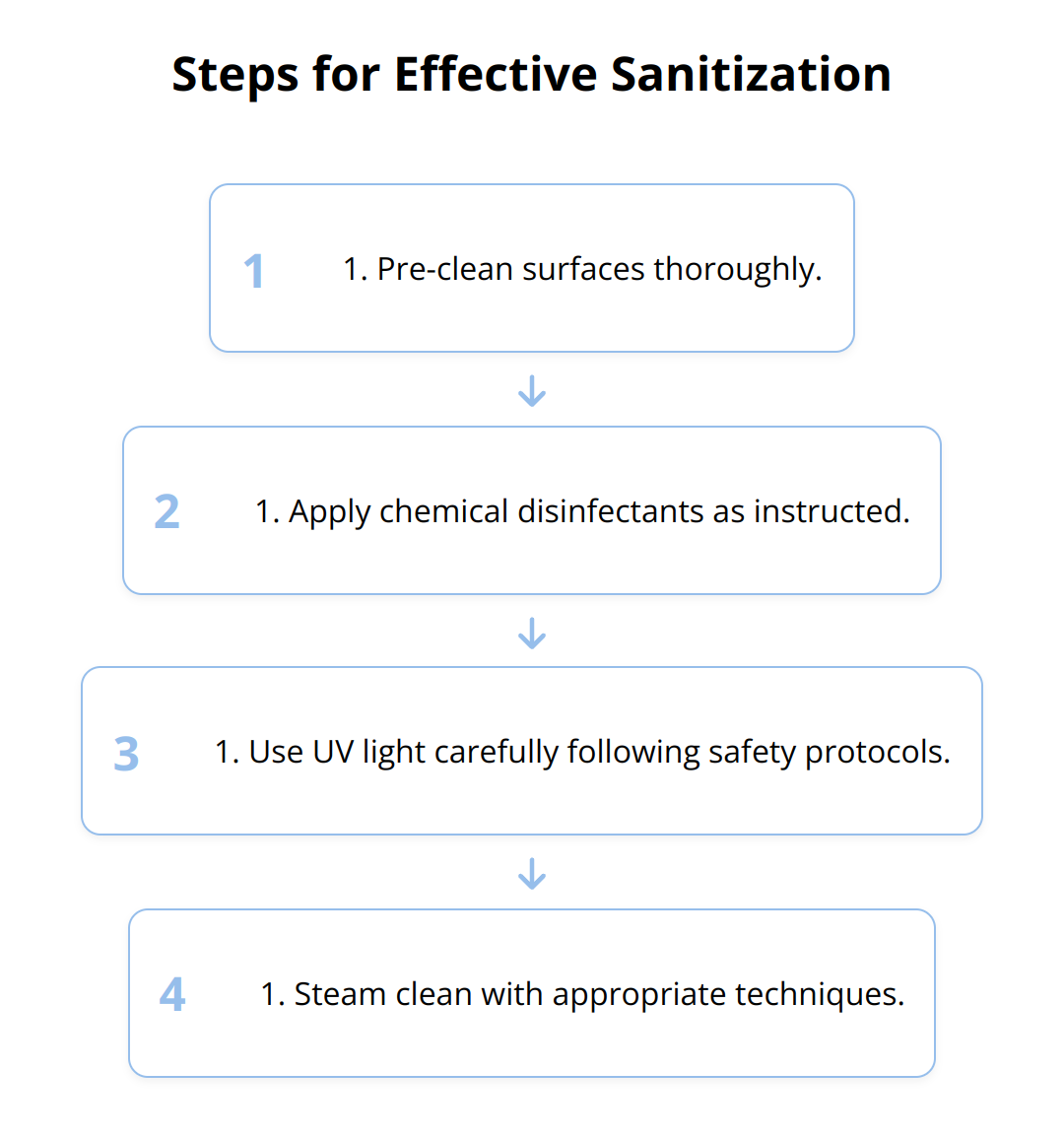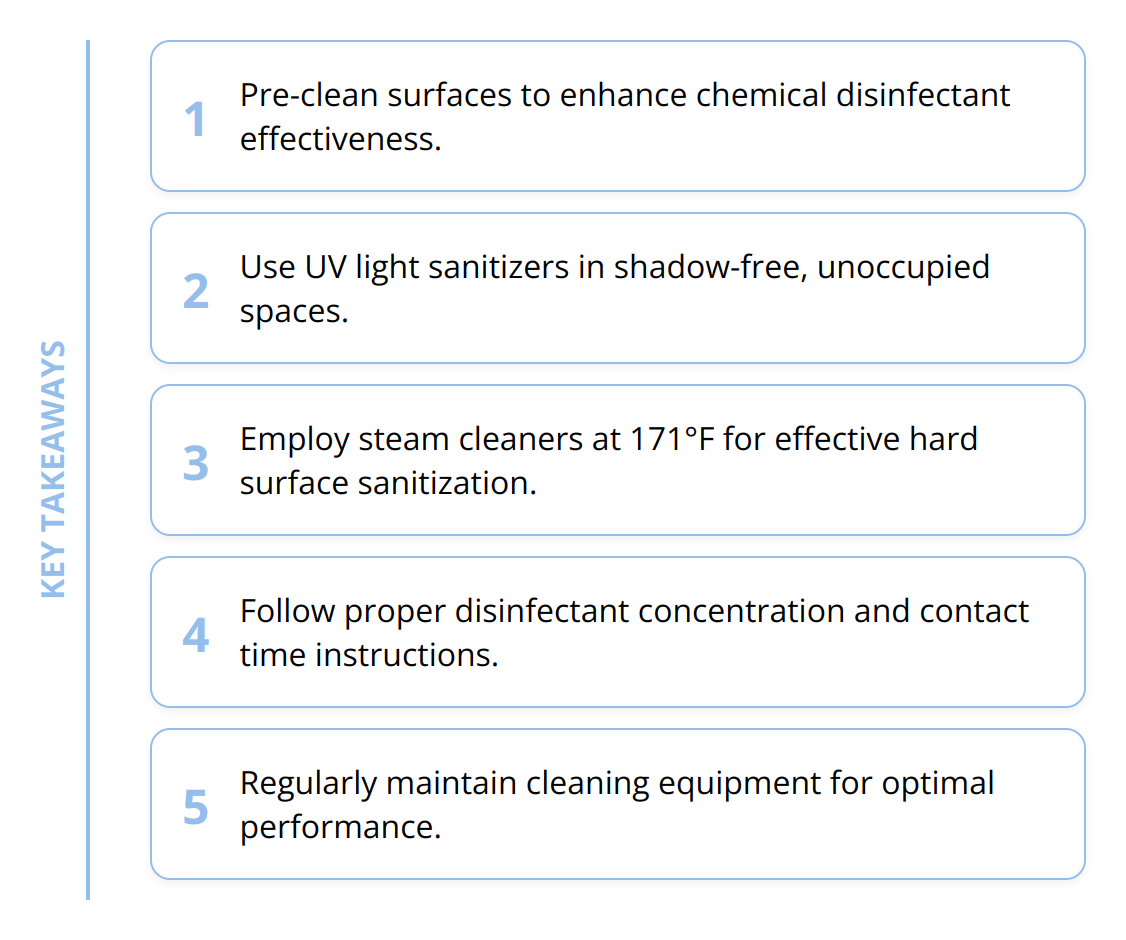Sanitizing surfaces is more important than ever. With various methods available, it’s crucial to know which techniques are both quick and effective.
In this post, we explore chemical disinfectants, UV light sanitization, and steam cleaning. At The A Team Cleaning Services, we bring you the facts and practical tips you need for optimal results.
How to Sanitize Surfaces Effectively
Surface sanitization can be achieved through several reliable methods. Among the most effective are chemical disinfectants, UV light sanitization, and steam cleaning. Here’s a closer look at each:
Chemical Disinfectants
Chemical disinfectants, like chlorine, iodine, and quaternary ammonium, are widely used in various settings. These agents have been proven to kill a broad spectrum of pathogens. For instance, chlorine-based products can eliminate up to 99.9% of bacteria and viruses within 30 seconds. However, proper application is critical for these products to be effective. Ensure surfaces are pre-cleaned to remove debris, allowing the chemical to work directly on germs. It’s also essential to follow the manufacturer’s instructions for concentration and contact time.
Tips for using chemical disinfectants:
- Pre-clean surfaces to remove visible dirt
- Use recommended concentrations for optimal results
- Allow sufficient contact time as indicated by the product label

UV Light Sanitization
UV light sanitization is gaining popularity, particularly in healthcare settings like hospitals and clinics, where it’s used to effectively reduce pathogens in rooms, on medical equipment, and high-touch surfaces. UV-C light, in particular, has shown significant efficacy in killing a variety of microorganisms. Studies confirm that UV-C can reduce bacterial counts by as much as 95% in just a few minutes. One of the key advantages of UV light is that it requires no chemicals, making it a cleaner alternative. Still, safety precautions must be taken to prevent exposure as UV-C light can be harmful to skin and eyes.
Benefits of UV light sanitization:
- Non-chemical method, reducing potential residue
- Effective within a short period, often under 10 minutes
- Can reach and disinfect nooks and crannies that might be missed during manual cleaning
For more on non-chemical cleaning methods, read about cleaning grout without toxins.

Steam Cleaning
Steam cleaning is highly effective for deep-cleaning surfaces without the use of chemicals. It is particularly effective on hard surfaces such as floors, tiles, and countertops. Steam at temperatures above 171°F can kill pathogens quickly. This method not only sanitizes but also helps remove dirt and grime efficiently. It’s environmentally friendly and poses no risk of leaving behind chemical residues. Regular use of steam cleaners can ensure long-term cleanliness and sanitation of your home.
Advantages of steam cleaning:
- Kills bacteria and viruses without chemicals
- Effective in removing stubborn dirt and stains
- Safe for various surfaces, including sealed hardwood and tiles
Steam cleaning is heralded for its ability to sanitize with just water, making it an eco-friendly choice. For more tips on eco-friendly cleaning, check out our eco-friendly cleaning guide.
Each of these methods presents unique advantages. Whether you choose chemical disinfectants, UV-C light, or steam cleaning, the key is consistent and proper application to ensure sanitization and a healthier environment.
Which Method is Best?
When choosing a surface sanitization method, it’s important to consider the pros and cons of each approach. While chemical disinfectants, UV light sanitization, and steam cleaning are all effective, they have different applications and limitations.
Chemical Disinfectants: These are known for their ability to quickly kill a wide range of germs. Chlorine-based disinfectants, for example, can eliminate up to 99.9% of bacteria and viruses in just 30 seconds. However, they require precise application to be effective. Surfaces must be pre-cleaned to remove debris, and the correct concentration and contact time should be followed. Chemical disinfectants can leave residues and have potential health implications, especially for those with allergies or sensitivities. Also, improper use can result in reduced effectiveness and increased risk of contamination.
UV Light Sanitization: This method is particularly useful in settings like hospitals and clinics. UV-C light can reduce bacterial counts by up to 95% within minutes. One of the primary benefits is that it doesn’t involve chemicals, which means no residues or additional waste are produced. Nevertheless, it has its limits; UV-C light can be harmful to skin and eyes if not handled properly. Additionally, its effectiveness diminishes in shadowed areas, so it might not reach all nooks and crannies.
Steam Cleaning: Utilizing steam at temperatures above 171°F, this method effectively eradicates bacteria and viruses without chemicals. It’s highly effective on hard surfaces like floors and countertops. Steam cleaning also excels in removing dirt and grime, making it a dual-purpose cleaning tool. Moreover, it’s environmentally friendly and leaves no chemical residues. On the downside, steam cleaning can be time-consuming, especially for larger areas, and might not be suitable for all surfaces. It’s also less effective in environments where rapid recontamination can occur.
Practical Tips:
- Pre-clean surfaces before applying disinfectants to enhance effectiveness.
- UV light is best for healthcare environments but requires safety precautions.
- Steam cleaning offers an eco-friendly choice, ideal for deep cleaning hard surfaces.
For those looking to prioritize eco-friendliness without sacrificing effectiveness, check out these sustainable cleaning routines. Each method has its ideal application, making it vital to select based on the specifics of the situation.

Choosing the right sanitization method involves weighing speed, effectiveness, and application requirements. While no single method is universally superior, understanding their advantages and limitations allows for informed decisions.
Practical Tips for Quick and Effective Sanitization
Sanitizing surfaces efficiently and effectively is essential. Here are best practices for each method discussed.
Best Practices for Using Chemical Disinfectants
Chemical disinfectants require precise application for maximum effectiveness. Here’s how:
- Pre-Clean Thoroughly: Always remove visible dirt and debris first. This allows the disinfectant to contact pathogens directly, increasing its effectiveness.
- Follow Manufacturer Instructions: Use the correct concentration and ensure that the chemical remains on the surface for the recommended contact time. For example, chlorine-based products often require at least 30 seconds to fully eliminate bacteria.
- Use Appropriate Protective Equipment: Wear gloves and, in some cases, masks to protect against possible irritants.
- Target High-Touch Areas: Focus on doorknobs, light switches, and countertops where germs accumulate quickly.
Safety Measures When Using UV Light
UV light disinfecting is highly effective but requires proper safety measures to avoid harm:
- Prevent Direct Exposure: Always avoid direct exposure to skin and eyes. Arrange for the area to be unoccupied during the sanitization process.
- Use in Shadow-Free Areas: Ensure the UV light can effectively reach all areas. For uneven surfaces or objects with multiple angles, reposition them so that the light covers everything.
- Regular Maintenance: Clean UV-C bulbs regularly to maintain their efficacy. Even a small layer of dust can reduce effectiveness significantly.
Research shows that UV-C light can kill up to 95% of bacteria within just a few minutes, making it a powerful tool, especially in high-traffic areas.

Proper Techniques for Steam Cleaning
Steam cleaning can be a game-changer for killing germs without chemicals, but must be done correctly:
- Use High Temperature: Ensure the steam reaches at least 171°F. Most commercial steam cleaners will achieve this effortlessly.
- Slow and Steady Movements: Move the steam cleaner slowly over surfaces to allow the heat time to kill pathogens effectively.
- Clean and Maintain Equipment: Regularly clean your steam cleaner to avoid buildup of grime and ensure it performs effectively.
- Ideal for Hard Surfaces: Use steam cleaning primarily on hard surfaces like tiles and hardwood floors for the best results.
Advantages of steam cleaning include being eco-friendly and leaving no chemical residues, which is particularly beneficial for homes with children or pets. For more on sustainable solutions, refer to our natural kitchen cleaners.

By integrating these practical tips into daily routines, you can achieve a higher standard of cleanliness and protect against pathogens more effectively.
Wrapping Up
Sanitizing surfaces quickly and effectively is crucial for maintaining a healthy environment. Chemical disinfectants, UV light sanitization, and steam cleaning each have their unique advantages. Chemical disinfectants are powerful and quick but require careful application. UV light offers a non-chemical option, ideal for healthcare settings but requires careful handling. Steam cleaning provides an eco-friendly solution that kills germs and removes grime without chemicals but can be time-consuming.

Key Takeaways for Quick Surface Sanitization:
- Pre-clean surfaces for better results
- Adhere to manufacturer instructions and contact times
- Use UV light carefully to avoid exposure
- Steam cleaning is a chemical-free method ideal for homes
Implementing these best practices can help you achieve a higher standard of cleanliness in less time. For a pristine and healthy living environment, consider professional cleaning services from The A Team Cleaning Services. Our experts use professional-grade products and equipment tailored to meet your specific needs, saving you time and promoting a healthier space. Check out our sustainable cleaning routines for more eco-friendly tips.
